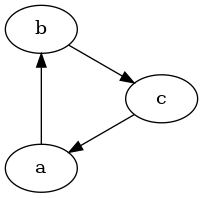Let $G$ be a vertex-labeled directed graph with unique labels $L$. Let $G_P$ be a path graph with the same vertex labels and the same number of vertices as $G$.
I know that in the general case computing the Graph Edit Distance is NP-hard (if approximations are excluded) and APX-hard to approximate.
I'm interested in a subset of the problem:
Is there a general algorithm for quickly computing the Graph Edit Distance from any $G$ to any $G_P$, restricted to only adding and removing edges?
Let, for example, $G=(\{a,b,c\}, \{(a,b), (b,c), (c,a)\})$:

Then the graph edit distance, excluding vertex addition/deletion, to the path directed graph $G_P=(\{a,b,c\}, \{(a,b), (b,c)\})$ is 1.
It feels to me like this is a case that's restricted enough that there should be an efficient algorithm for computing the distance, but I might be mistaken.
Furthermore, for a given directed vertex-labeled graph, is there a known algorithm for finding the set of labeled path graphs with the minimal graph-edit distance to the original graph?
So far, for both questions, I haven't been able to find an answer (google scholar gives only semi-related answers to "graph edit distance to linear graph" and "graph edit distance to path graph".
Context for why I'm asking the question, probably not relevant to the answer.
